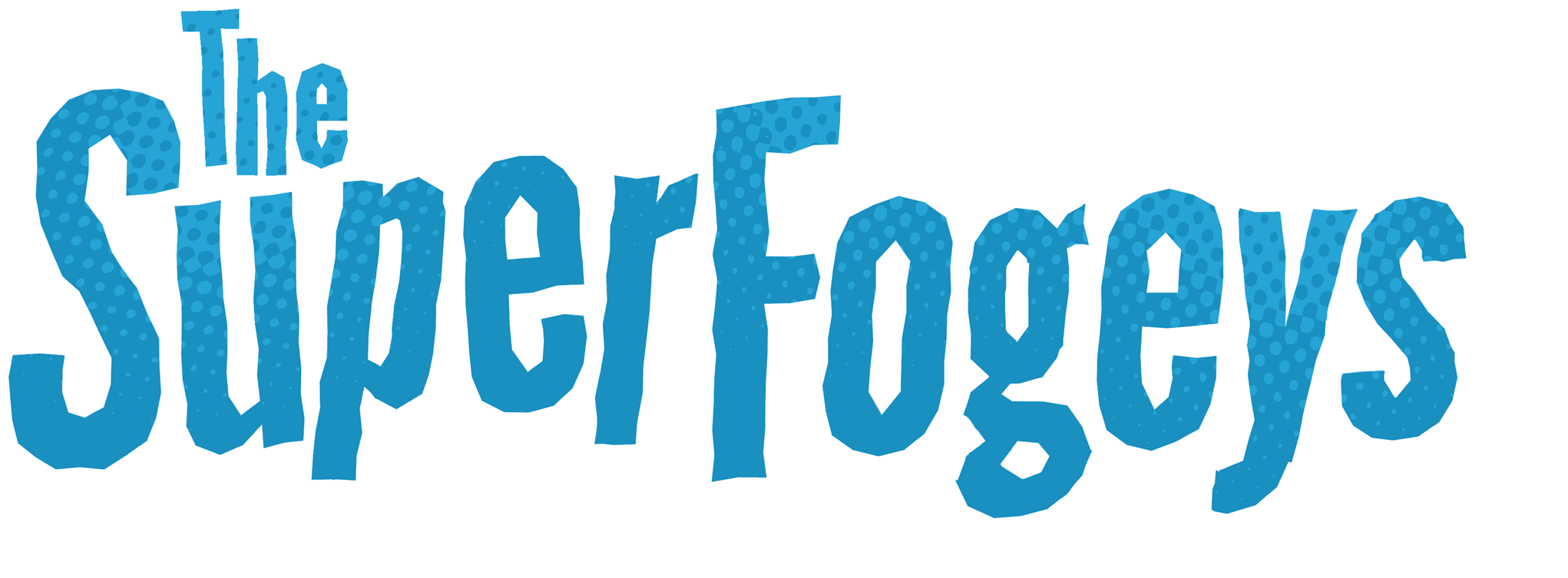THE ANNOTATED SUPERFOGEYS 256
This is admittedly a strip that draws on a lot of continuity. Well, some. This whole chapter is going to be like this. Hopefully, you longtime readers will see this as a reward for your investment. As for the newbies…well, that’s what the annotations are for!
Okay, on with it.
The Thrice Evil is one of those background characters that hardly ever says anything. Now you know why. His outburst at Herman’s funeral was a big moment for him, and was precipitated by something we saw in Herman’s origin.
Now you know. See, that wasn’t so bad, was it?
THE CREATIVE PROCESS BEHIND SUPERFOGEYS ORIGINS
On Tuesday, I got into a great discussion with SuperFan Evil Emperor Nick about the nature of SuperFogeys Origins and some of the limitations inherent in the short origin stories I’ve been telling. This gave me a chance to detail how I make the SuperFogeys Origins machine go. I thought it might be interesting to some of you who are creative process junkies like me, so I now present to you my comments from Tuesday in edited form with additional comments.
Would love to hear your thoughts–and I’d especially love to hear the perspective of those artists I’ve worked with on SFO! Here you go:
Writing the SuperFogeys Origins stories can be tricky business.The length of these stories can be very frustrating–especially with one like Star Maiden where there’s so much ground to cover. I can’t really delve into the larger issues in a short story, all I can really do is just touch down on different points in her life and trust the reader to fill in the blanks.
(Which, in some ways, is the truest way to write a comics story anyway. In comics, if you think about it, it’s really about what happens in between the panels that’s most important–that’s the part where the reader actively participates in the storytelling.)
Let me tell you a bit about how a SFO story comes to be. It usually starts with me contacting an artist whose work I like and think they might be a good fit for SFO. I’m looking for something very specific. I then ask them if they’d like to do draw a story for me for no money whatsoever. Surprisingly, most say yes (there have been a few no’s, but not as many as you’d think).
Once the artist agrees, that’s when the conversation begins. We start by talking about which characters are their favorites and what kinds of things they like to draw (some don’t really care). Most importantly of all, I ask them how many pages they’re in for. It can range anywhere from 2 to 9. Most prefer to do no more than 5.
At that point, it’s up to me to think up the story. It’s rare that I have a story in mind already that I then bring to an artist. I try to keep in mind the artist’s art style and what they’re comfortable with. If I can accommodate their character choice, all the better. (For example, I recently contacted Chris Watkins of Odori Park to do an Origin and he seemed really keen on drawing the women of the SuperFogeys ‘verse. So, I came up with a story where Spy Gal, Star Maiden and the Pink Shade all go to a fashion show–don’t worry, punches are thrown too.)
So, what you’re seeing most weeks is a labor of love for which I am the beggar and not the chooser. That’s why so many of these stories are so short. Consequently, some stories are served well by that length and some can end up feeling truncated if I’m trying to do too much–which does happen on occasion.
With the “Society of Heroes” origin, I was in a unique situation where I was working with T.L. Collins who had made a long term commitment to SFO. This afforded me the opportunity to do a longer story right out of the gate–that one clocked in at 22 pages! It was awesome and it was fun, but I knew it couldn’t last. Most artists have other things they want to do and if they’re going to do something for someone else they’re gonna need to be paid to justify the commitment. I lucked out with TL.
When I broke the Star Maiden story I knew it was one I could have easily expanded to 22 pages. Easily. But, knowing I couldn’t do that and that I had a great artist like Wes Molebash with me on it, I thought I could get the job done in five pages (since expanded to six). I don’t think there’s any arguing against the idea that a 22-page version would work much better, but I’m actually quite pleased with how it’s turned out. Is it as deep and involving as a longer story could have been? No, but I do think it succeeds on its own terms. It was either those terms or not tell the story at all. And I’m glad I told the story the way that I did.
That’s often the choice I’m making. I’m always cutting, always editing. I can either tell the stories to the best of my ability in the number of pages I have to work with…or I can not tell the stories at all. I could just turn SFO over to the kinds of stories like “Spy Gal vs. Star Maiden,” a fun little gem that was a break from the origins…and that lots of people didn’t much care for. Those kinds of stories work well in the short format. They’re mostly inconsequential, give us a little peek into the past, and they don’t require complicated plotting.
But…I’m a sucker for complicated plotting. I like high stakes and big ideas. So, yeah, you’ll probably see more dense, short origins. I’ve gotta work within the parameters the people I work with are comfortable with.
All that said, EENick’s criticism about how the short nature of the Star Maiden Origin seemed robbed of characterization and made it it difficult to care about the characters is already influencing how I approach SFO in the future. Tuesday morning, I talked to David Reddick and Lee Cherolis, the art team behind the upcoming Spy Gal Origin, about the possibility of adding additional pages to the story to let things breathe a little more. They were agreeable to this and I’m really looking forward to diving back into my outline and decompressing things a bit so that we get to know the new characters better and feel the weight of the twists and turns more. It’s going to be a lot of fun.
One other solution that EENick brought up was to have multiple artists working on the same story. That’s a really great idea, and one I batted around for a while before ultimately deciding that it wasn’t practical. One of the other realities of working with people I don’t really know who have lives and their own artistic endeavors to take care of is that I never really know when an origin will be completed. It may seem like everything runs like clockwork since I’ve been doing SFO for over a year and have never missed even one week, but that’s because I stack the deck a little.
At any given time I’m working with up to five or six artists at once and the mandate is the same to all of them–work at your own pace. For some people, that means just a few weeks until I get finished pages (I think Marc Lapierre holds the record–I asked him to draw “When Tom Met Ms. Missile”and within a week I think I had both pages inked and ready to go), and for others it means months and months. I don’t judge and I try not to poke and prod too much.
One of the reasons I’m able to get so many talented artists on SFO is, I think, because of the combination of professionalism and comfort I try to establish at the outset of each collaboration. It’s EXTREMELY important to me that each artist have a good time working on their story and that it’s not a burden. If it becomes a burden, then I encourage them to bow out, as was the case with David Reddick last year when it just wasn’t feasible for him to do the “Spy Gal vs. Star Maiden” story as originally intended and Krishna Sadasivam gamely stepped in and freakin’ rocked it.
What all of this means is that trying to coordinate, say, three different artists on one story would leave it open to things not being done in a timely manner and undue pressure might be placed on the artist who perhaps is a bit slower than the others. Worst case scenario: the story isn’t done on time and weeks go by with no SFO updates. Keeping each origin contained within the talents of two or three people affords me a lot of luxuries that I might not otherwise have.
In the end, it’s the difference between a paying gig and a non-paying gig. One day, I hope to pay all of my artists, but until that day comes I have to very careful about how demanding I am. These are the realities. And no, I didn’t know any of this when I first started doing SFO. Everything I’ve written here comes from a year and a half of experience. I like to think I’ve gotten pretty decent at managing the SFO machine and that I give lots of great artists a chance to shine and have some fun. (I suppose you’ll have to ask them about that!) But one thing I do know for sure: the unique nature of what I’m doing with SFO (and, really, can you name any other webcomic that’s doing anything remotely like it?) does demand certain storytelling realities.
All part of the fun and the challenge, right?
NEXT WEEK:
Star Maiden’s Origin concludes on Tuesday with the final art by Wes Molebash. I haven’t seen it yet, but it promises to be his best page yet!
Then, on Thursday, the Thrice Evil and Dr. Klein have words. Be there!




[…] big revelation with this strip hearkens allllll the way back to this strip, when we saw for the first (and only) time what the Thrice Evil of Earth-Abaddon would be like were […]
[…] If you’ll recall: not if Jerry has anything to say about it. […]